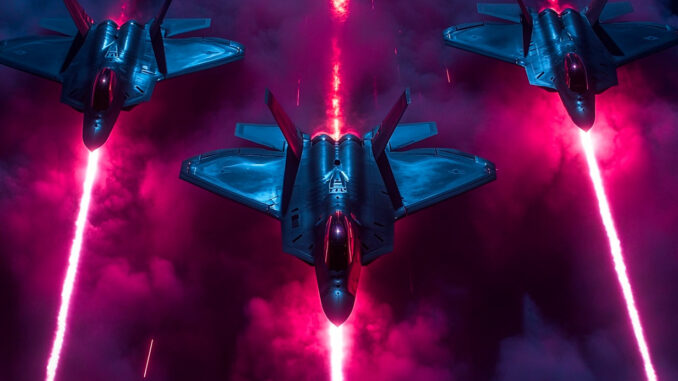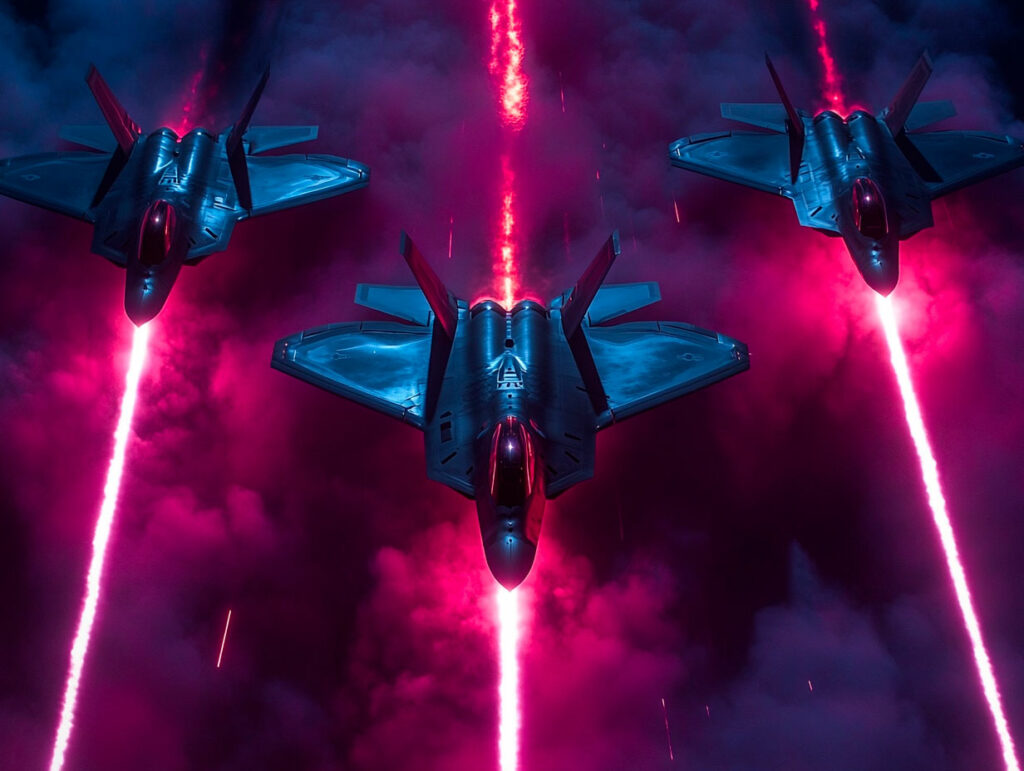
Lasers mounted on the F-35 and F-22 will bring combat capabilities at the speed of light, reshaping the landscape of air warfare.
Laser weapons mounted on fighter jets, such as the F-35 and F-22, could revolutionize air operations by enabling strikes at the speed of light. These weapons aim to intercept missiles, neutralize aerial or ground targets, and burn through enemy vehicles. While some programs have been paused, technological progress is advancing rapidly, and initial tests have shown promising results. The development of miniaturized mobile power systems and thermal management are key challenges to overcome before these technologies can be operational on fighter jets.
Technological challenges of airborne laser weapons
Laser weapons represent a significant leap in air defense technology, but their integration on fighters like the F-35 and F-22 remains challenging. While these technologies are already used on larger platforms such as warships or ground vehicles, fighter jets face specific constraints in terms of weight, space, and energy management.
Laser weapons require a substantial amount of energy to be effective. On ships or ground installations, space is not an issue, but fighters must incorporate this technology into very confined spaces. One of the main challenges is creating miniaturized mobile power systems capable of generating enough electricity to power high-energy lasers. Effective thermal management systems are also crucial, as lasers generate intense heat that can affect other electronic systems on board.
Recent laser weapon programs, though some have been halted, have made significant progress in developing systems capable of handling these constraints. The miniaturization and increase in power density of electrical systems are key advancements in this area. For example, a 30 kW laser system could require batteries weighing approximately 300 pounds (136 kg) and occupying a volume of 0.5 cubic meters, according to data from the Air Force Research Laboratory (AFRL). These advancements are bringing lasers on fighter jets closer to becoming a reality in the near future.
Strategic advantages of lasers in aerial combat
Lasers offer major advantages over conventional weapons. Unlike missiles, lasers can strike at the speed of light, significantly reducing reaction time against threats. Moreover, lasers are highly precise, allowing for surgical strikes on multiple targets without the need for rearming, unlike missiles that must be replaced after each use.
Another key advantage of lasers is their scalability. By adjusting the laser’s power, it is possible to either completely destroy a target or merely disable it. For example, an enemy aircraft could be rendered inoperative without being destroyed, which could be useful in situations where civilians are nearby or when critical infrastructure needs to be preserved.
Lasers are also a more cost-effective option compared to missiles. Each laser shot costs only a fraction of what a missile does, leading to long-term savings, especially in scenarios where multiple targets must be engaged simultaneously. Combining these advantages, lasers could become one of the most important combat technologies of the 21st century.

Progress made by the Air Force and ground tests
The Air Force Research Laboratory (AFRL) has been working on aircraft-mounted laser weapons for several years, with several ground tests already conducted. These tests have verified the ability of lasers to be integrated into pods mounted on aircraft. The first airborne tests are expected to take place on cargo planes like the C-130, which have the space and power capacity needed for large-scale trials. These aircraft will serve as test beds for lasers before they are integrated into smaller fighters like the F-35 and F-22.
Solid-state laser weapons, which rely solely on electricity, are particularly promising for military applications, as they do not require the use of specific chemicals like other types of lasers. This simplifies their use and maintenance while improving their reliability. Solid-state lasers can generate extreme levels of heat, allowing them to disable or destroy targets in a single shot.
These advancements bring the AFRL closer to its goal of equipping fighter jets with functional lasers in the coming years. The airborne tests planned for cargo planes will evaluate the feasibility of lasers in real combat conditions and further improve them for integration on smaller, faster platforms.
Economic and strategic implications of airborne lasers
The integration of lasers into fighter jet weapon systems could transform the global military balance. In addition to providing precise strike capabilities at lower costs, these weapons could reduce the need for conventional munitions, freeing up space and weight on aircraft. This would improve their autonomy and reduce costs related to refuelling and mission logistics.
An aircraft equipped with lasers could remain in flight longer without the need for resupply, thus increasing its dwell time on the battlefield. Additionally, with lighter munitions, fighters could improve their maneuverability and fly faster, enabling them to respond more quickly to emerging threats.
The strategic implications are also significant. By allowing pilots to engage multiple targets simultaneously and neutralize threats more rapidly, lasers provide a decisive advantage in aerial combat. Furthermore, they enable the degradation of enemy targets without destroying them, a capability not always afforded by traditional munitions.
Challenges to overcome before operational integration
Despite the numerous advantages, several technical challenges must still be addressed before lasers become standard weapons on fighter jets. One of the main obstacles is managing the heat generated by lasers. Efficient thermal management systems must be developed to prevent the heat produced by lasers from compromising other onboard systems.
Vibrations and turbulence during flight are another major challenge. For lasers to be effective, they must aim with extreme precision. However, aircraft movements can create optical disturbances that affect the stability of the laser beam. Advanced beam control systems are therefore needed to compensate for these disturbances and ensure accurate targeting.
Lastly, lasers must be robust enough to operate in the hostile environments faced by fighter jets, such as high altitudes and extreme temperatures. If these challenges are overcome, laser weapons could become operational in the coming years, opening a new era in aerial warfare.
War Wings Daily is an independant magazine.